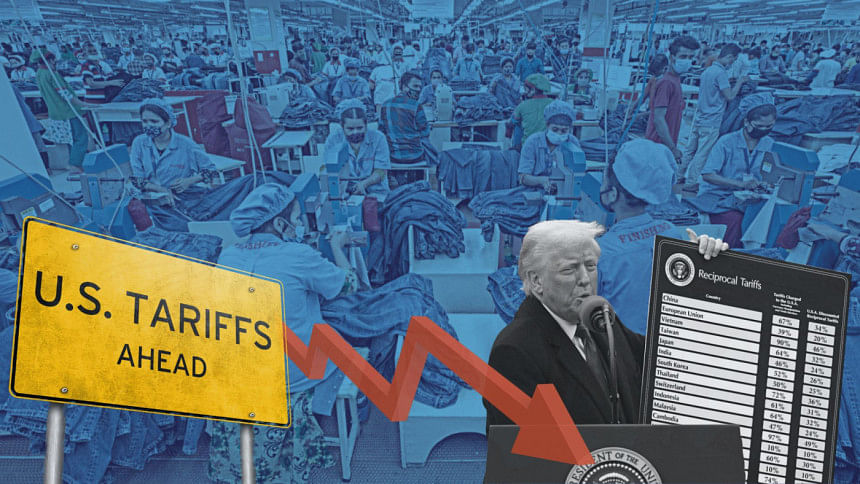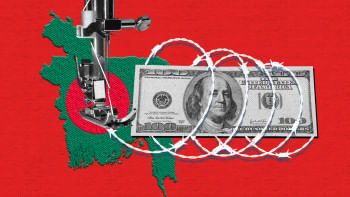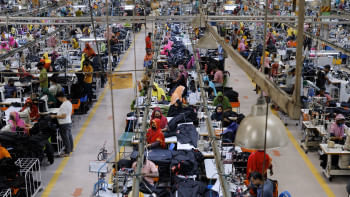How we can navigate the tariff maelstrom

The importance of the readymade garment (RMG) sector to the Bangladesh economy cannot be overstated. Contributing 85 percent of the country's export earnings, 11.5 percent of GDP, and providing employment to over four million workers, the sector has been a pivotal force behind Bangladesh's GDP growth, rural-to-urban wealth distribution, and economic empowerment of women over the past two decades. Given its role in the economy, any local or global headwinds affecting the sector have significant macroeconomic implications, raising concerns among economists, policymakers, and industry leaders alike.
The latest tariff impositions by the Trump administration, followed by a 90-day freeze, have triggered unwanted disruptions in the global trade system. Bangladesh must assess the broader consequences of these tariffs, especially on its trade flow and export competitiveness.
As RMG remains Bangladesh's top export, and with the United States as its largest single-country export destination, the sector is vulnerable to any protectionist measures. To formulate an effective response, it is essential to understand the concerns of the US administration, which seeks increased imports of American goods and higher foreign direct investment (FDI) into the US economy. While Bangladesh's limited capital stock and regulatory constraints make large-scale FDI unlikely, there is potential to expand imports of basic agricultural commodities from the US—such as cotton, oilseeds, and vegetable fats. These arrangements could be pursued through both government-to-government (G2G) initiatives and private sector partnerships, offering a diplomatic lever in ongoing trade discussions.
Understandably, industry leaders are alarmed by tariff hikes as steep as 37 percent on Bangladeshi apparel—even as some competing countries face similar increases. This raises critical questions: how competitive will Bangladesh remain in the midst of this trade war? What should be our strategic response to mitigate potential setbacks to this vital sector?
While international trade will inevitably slow, the impact will not be evenly distributed. Emerging economies like Bangladesh may find new opportunities as global supply chains realign. China, the largest apparel exporter to the US with a 21.3 percent market share, faces the highest tariff rates—bringing the total to over 100 percent on certain categories. This opens the door for Bangladesh and Vietnam to absorb some of the redirected orders from China. The challenge, however, lies in Bangladesh's current limitations in producing higher-value apparel and man-made fibre (MMF)-based products, where global demand is surging.
In 2024, MMF-based apparel made up only about 29 percent of Bangladesh's production, compared to the global average of 78 percent, according to the International Textile Manufacturers Federation. To remain competitive, especially in the European Union (EU) market—where stringent sustainability regulations are gaining momentum—Bangladesh must invest in MMF capacity, sustainable production systems, and a recycled fabric ecosystem.
The new tariff regime is also expected to trigger inflationary pressures in the US, with forecasts suggesting a rise from two to four percent. Historically, in times of economic uncertainty and stagflation, US consumers gravitate towards affordable, fast-fashion products—a market segment where Bangladesh has a significant foothold. Notably, during the aftermath of the global financial crisis, Bangladesh's apparel exports surged by 44 percent in 2010-11 compared to the previous year.
To successfully navigate this volatile environment, Bangladesh's apparel sector must pursue a "triple diversification strategy": i) geographic diversification which involves reducing dependence on Europe and the US, and exploring emerging markets; ii) fabric diversification by increasing MMF-based and recycled fabric production; and iii) product diversification by shifting towards higher-value and varied product categories.
Simultaneously, our diplomats and trade negotiators must proactively engage US counterparts, advocating for increased procurement of US cotton, which currently accounts for just nine percent of Bangladesh's imports. Redirecting sourcing from Brazil, India, and West Africa to the US could bolster diplomatic goodwill. Additionally, marketing Bangladeshi apparel as "Made with US cotton" could strengthen our position during trade negotiations. Ensuring that our tariff rates remain at par with, or lower than, those of key competitors such as Vietnam and India must also be a top priority.
Rather than viewing the Trump-era tariffs solely as a threat, Bangladesh can treat them as a once-in-a-decade opportunity. Proactive policy measures, diplomatic engagement, and industry readiness can help absorb the shifting orders from China while adhering to sustainable practices and diversifying our export portfolio. In doing so, Bangladesh can not only withstand the current trade disruptions but also accelerate towards the sector's ambitious target of achieving $100 billion in exports in the coming years.
Zahedul Amin is a co-founder and managing director at LightCastle Partners. He can be reached at [email protected].
Views expressed in this article are the author's own.
Follow The Daily Star Opinion on Facebook for the latest opinions, commentaries and analyses by experts and professionals. To contribute your article or letter to The Daily Star Opinion, see our guidelines for submission.

 For all latest news, follow The Daily Star's Google News channel.
For all latest news, follow The Daily Star's Google News channel. 





Comments